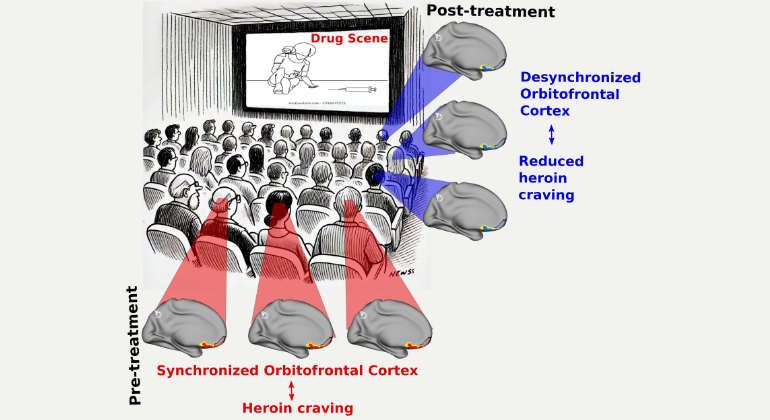2025-05-14 マウントサイナイ医療システム(MSHS)

Graphical representation of the study. Image credit: Mount Sinai Health System
<関連情報>
- https://www.mountsinai.org/about/newsroom/2025/academy-award-nominated-movie-helps-researchers-identify-brain-region-biased-towards-drug-cues-and-treatment-effects-in-individuals-with-heroin-use-disorder
- https://academic.oup.com/brain/article-abstract/148/5/1778/7895715
薬物をテーマとした映画に対する眼窩前頭葉の共有動態がヘロイン中毒における渇望と回復を追跡する Shared orbitofrontal dynamics to a drug-themed movie track craving and recovery in heroin addiction
Greg Kronberg , Ahmet O Ceceli , Yuefeng Huang , Pierre-Olivier Gaudreault , Sarah G King , Natalie McClain , Nelly Alia-Klein , Rita Z Goldstein
Brain Published:12 November 2024
DOI:https://doi.org/10.1093/brain/awae369
Abstract
Movies captivate groups of individuals (the audience), especially if they contain themes of common motivational interest to the group. In drug addiction, a key mechanism is maladaptive motivational salience attribution whereby drug cues outcompete other reinforcers within the same environment or context. We predicted that while watching a drug-themed movie, where cues for drugs and other stimuli share a continuous narrative context, functional MRI responses in individuals with heroin use disorder (iHUD) will preferentially synchronize during drug scenes.
Thirty inpatient iHUD (24 male) and 25 healthy controls (16 male) watched a drug-themed movie at baseline and at follow-up after 15 weeks.
Results revealed such drug-biased synchronization in the orbitofrontal cortex (OFC), ventromedial and ventrolateral prefrontal cortex, and insula. After 15 weeks during ongoing inpatient treatment, there was a significant reduction in this drug-biased shared response in the OFC, which correlated with a concomitant reduction in dynamically-measured craving, suggesting synchronized OFC responses to a drug-themed movie as a neural marker of craving and recovery in iHUD.

